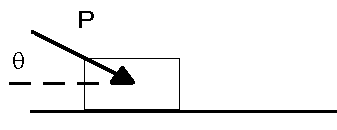
Teaching Physics with the Physics Suite
Edward F. Redish
Home | Action Research Kit| Sample Problems | Resources | Product Information
Problems Sorted by Type | Problems Sorted by Subject | Problems Sorted by Chapter in UP
 |
Teaching Physics with the Physics Suite Edward F. Redish Home | Action Research Kit| Sample Problems | Resources | Product Information |
Problems Sorted by Type | Problems Sorted by Subject | Problems Sorted by Chapter in UP |
A block with mass 12.0 kg is being pushed along a horizontal floor by a force P as shown in the following diagram. At clock reading t=0.00 s and position x = 0.00 m the block has an instantaneous velocity of 2.00 m/s. The angle is θ = 0.35 rad. The force P is applied to the block at the instant it is in position x = 0.00 m. The direction of P remains fixed, but its magnitude varies with position as shown in the graph at the right. The coefficient of sliding friction between the block and the floor is 0.2.


* Based on a problem in [Arons 1990].
Page last modified November 7, 2004: PE22